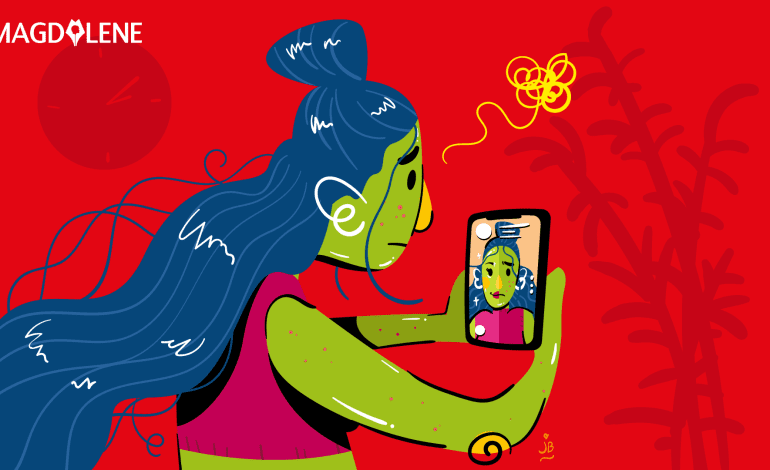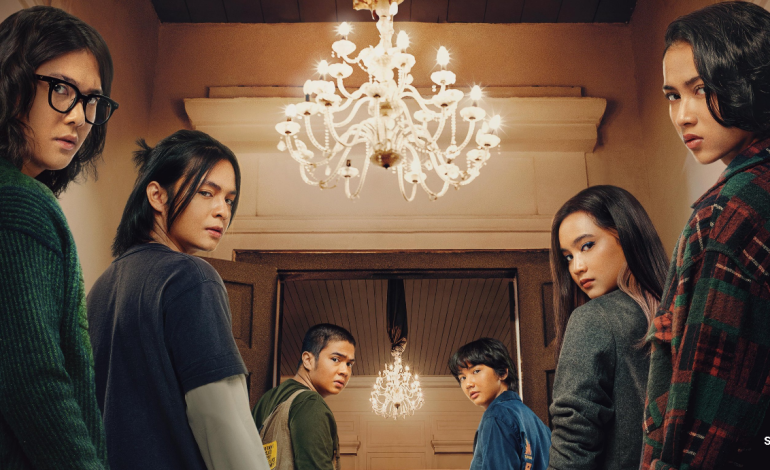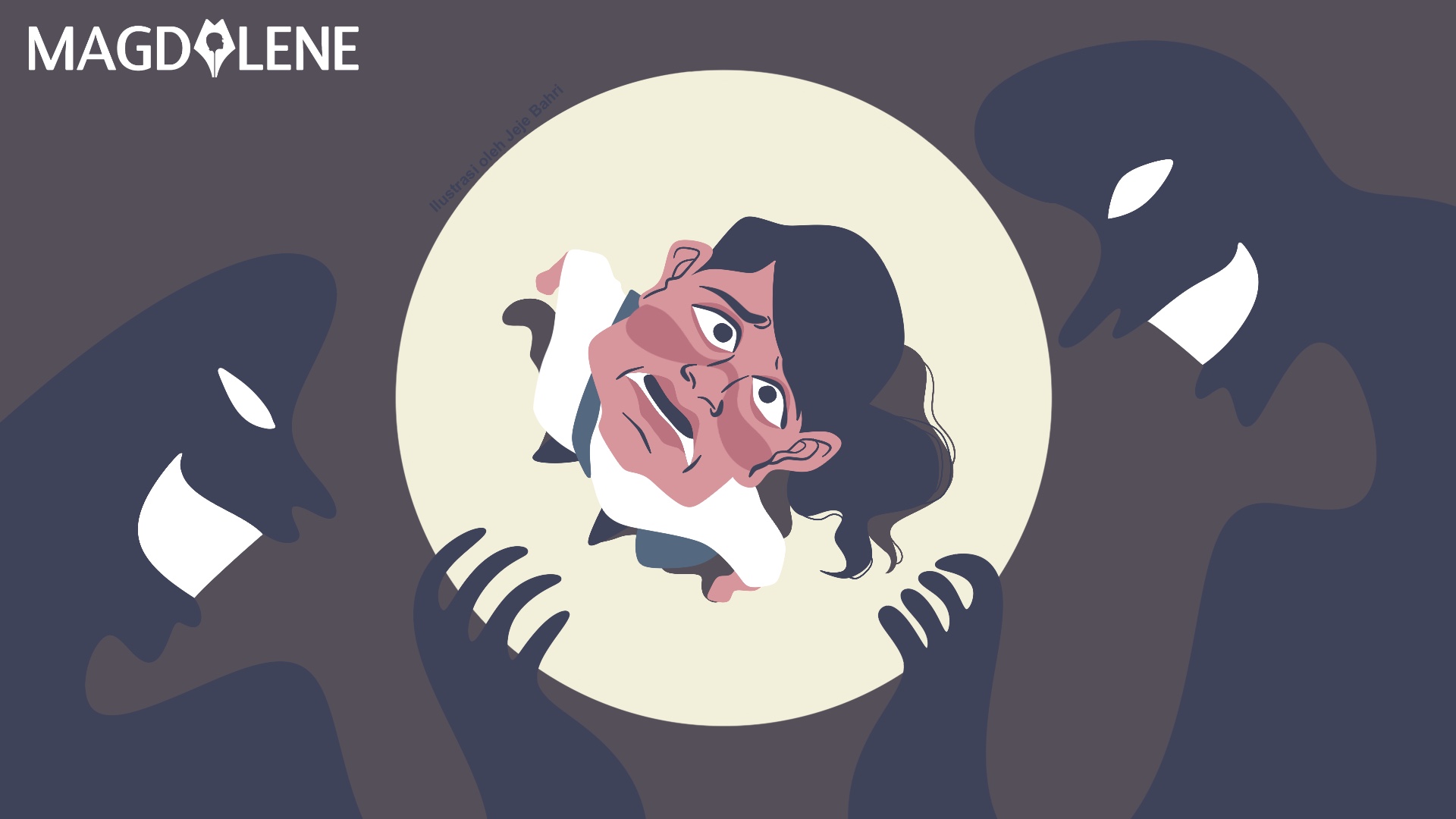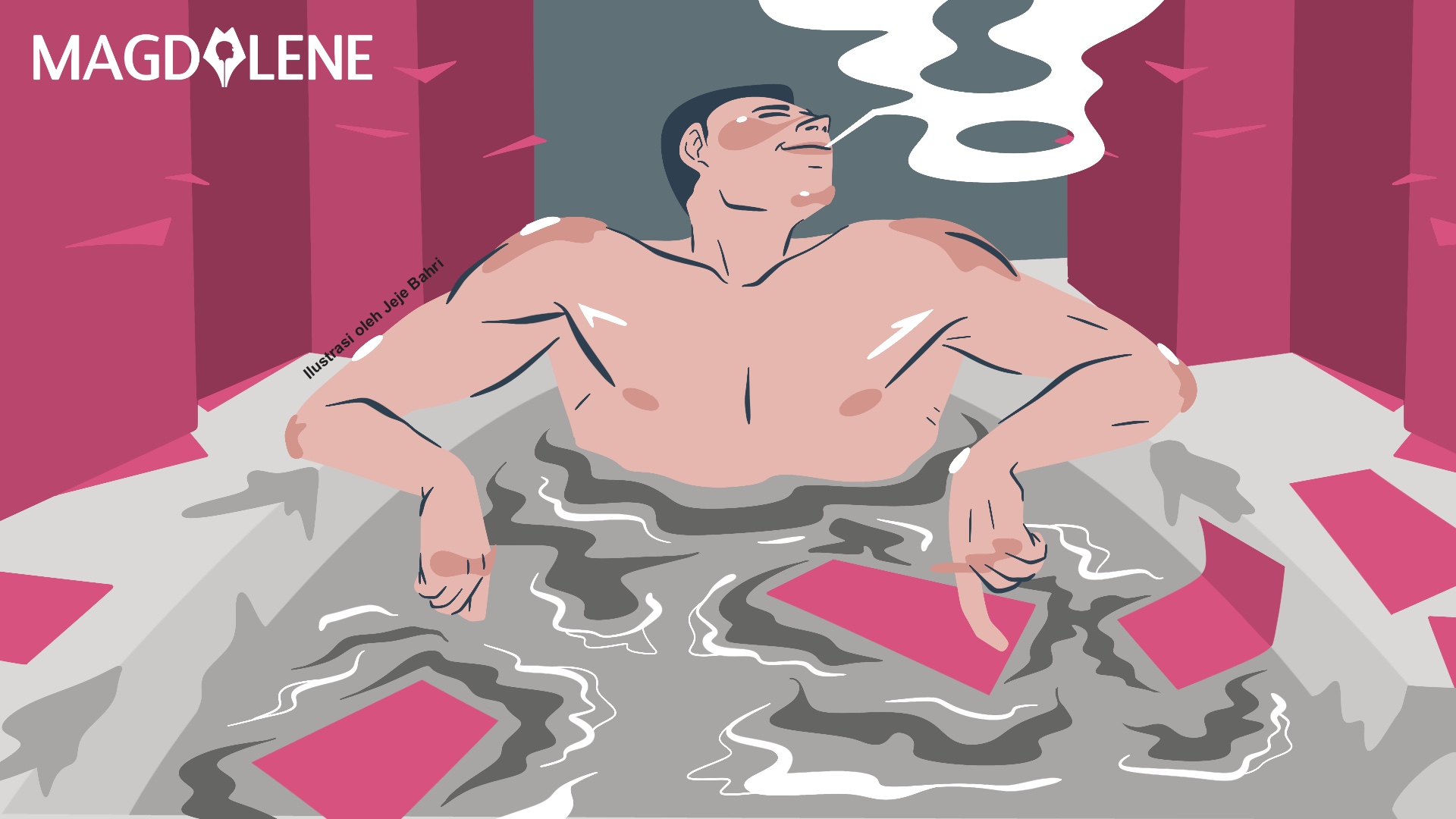Filter Dysmorphia: Catch-22 or Acceptable Progress?
How often do you use filters? Does it have any effect on your insecurity?

At around 4 p.m., when the sun is still shining brightly, Sonia rises from her bed, picks up her cell-phone, and walks towards the window. She opens Instagram, her go-to app for selfies, and clicks on the camera, which instantly shows her face. Holding the phone with both hands, she tilts her head left and right to study her best angle, before pressing the shutter button.
Almost immediately, the resulting photo makes her feel bad: her asymmetrical face, her acne scars. Soon, though, her insecurity was overcome once she applies the “Golden Bloom” filter.
For ten years now, Sonia, a civil servant, has depended on augmented reality (AR) to boost her self-confidence. The first beauty filters app she used on the first smart phone she owned wereB612 and Camera360. Since then, more photo editing apps with various features have popped up in the market. Camera360, an app developed by Pingguo, a startup based in Chengdu, China, remains one of the most popular ones.
The app, according to Tech Crunch, is one of the most successful in the world, with over 180 million users in 200 million countries.
In 2015, Snapchat released filters through its Lenses features that became hugely popular. Users can pick from seven available filters for photos and videos. Two years later, Instagram followed on Snapchat’s trails in the AR industry.
As a Gen-Z, I have been accustomed to filters on social media since high school. I used to think they were merely used for fun, with so many varieties of beauty filters to transform the users’ appearance. However, I have since discovered that the use of beauty filters goes beyond mere recreational purpose, especially when many, like Sonia, use them to perfect their physical appearance. I ask Sonia why she uses beauty filter.
“To make my face look symmetrical, to cover up my acne scars, and to brighten my dark lips. That way I can look good even without makeup,” she says.
Where she’s from in PematangSiantar, North Sumatra, attractiveness means fair skin, straight hair, sharp nose, and slim frame, the Eurocentric standard that is also predominant across Indonesia and much of Asia. Beauty products that claim to lighten the skin are highly sought out.
“I still internalize these beauty standards to this day,” she admits. Personally, she sees beauty in others as something deeper – their personality – still, when it comes to herself, she will only feel beautiful when she is acne free.
“That’s why I prefer to take pictures with Instagram, because it has filters,” she says, laughing.
In June, Magdalene conducted an online survey on perception and behavior on physical beauty. Some 35.5 percent of over 700 respondents admit to using beauty filters in their social media apps occasionally, citing a lack of self-confidence as one of their main reasons for using filters. Not everyone agrees, however.
Kevin, an employee for a private company, says he feels less confident when using beauty filters.
“This doesn’t look like me,” Kevin says, mimicking his own reaction when using beauty filters. For him, uploading photos with beauty filters is akin to providing content that doesn’t reflect him on social media merely to please others.
“How can we alter our appearance so drastically with a filter? I am me, I don’t need to [look] like I have more prominent cheekbones, even though I actually do want them,” he says, adding that he prefers non-beauty filters like black and white theme.
With its easy accessibility and endless varieties, beauty filters have perpetuated harmful beauty standards, a fact even admitted by a creator of beauty filter.

Imam Arifin, a Boyolali, Central Java, native have created beauty filters for Instagram and TikTok since 2020, with users totaling 87 billion on TikTok and one billion on Instagram. At first, Imam who works full time in the music industry, saw an opportunity in the Instagram filter creators that mostly only work with presets. He then adapted the works of overseas filter creators, not just adding eyelashes and lipsticks, and making the chin look smaller, but also making them more suitable to Indonesians’ taste.
“This filter is called deformation. Most Europeans and Americans love full lips, tanned skin, and with long lashes. I adapted from there,” he says. He lightens the skin complexion, knowing that most Indonesian netizens do not desire tanned complexion.
“Whether I like it or not, I had to alter the skin tone, making it fairer and customizing it with the type of makeup that Indonesians wear, so it doesn’t look too over the top,” Imam admits.
It made his beauty filters viral and used by many. He admits to drawing inspiration from K-pop. Using artists like Blackpink’s Lalisa Manoban’s makeup as an example, he would adjust the color of the lipstick, blush on, and the soft lens color. His income from the side job of producing beauty filters has surpassed that of his main job, he says, saving him financially throughout the pandemic.
Profit aside, there has been more recognition of the dark side of beauty filters: the body dysmorphic disorder (BDD), a mental disorder caused by anxiety over one’s physical appearance and perceived imperfections.
According to Clinical Psychologist Syazka Narindra, BDD can happen when people constantly focus their attention on the parts of the body that they deem imperfect. Beauty filters play a role when people are obsessed with themselves while using the filters, so much so that they desire to look like their filtered looks.
Beauty filter definitely improve sits user’s appearance: ceramic smooth skin, cute nose and perfectly shaped lips, high cheekbones, pointy chin, defined jawline, even Bella Hadid’s fox eyes. These changes give false expectations to its users and may leave them dissatisfied when faced with the reality of their own natural look.
This has also become one of the main factors behind the decision of social media users to undergo esthetic surgery. In 2017 the American Academy of Facial Plastic and Reconstructive Surgery stated that 55 percent of surgeons noted that (attractive) selfies had become the motivation for their patients to alter their body.
The data also show that beyond its link to social media, esthetic surgery to alter physical appearance is no longer considered taboo than, say, two or three decades ago. The question is: Does this paradigm shift amplify unrealistic beauty standards, or does it help us get closer to positive body image?
Also Read: How Has Beauty Standards Destroyed Women?
The Growth of Esthetic Industry and Beauty Standards
For boomers and Gen X, there are stigmas still attached to esthetic facial surgery. To this day, when watching television, my parents often make disparaging comments on public figures whose look have perceptibly changed.
“Look, her nose is different, she used to have a button nose. She must have had surgery,” Mom says when she sees a singer performing on TV. In her opinion, cosmetic surgery is a sin because it alters what God has given.
Singer, artist, and activist Kartika Jahja, who is a vocal advocate of body positivity, sees generational mindset contributes to the taboo surrounding esthetic. She admits that she is part of a generation that finds it hard to accept that someone can undergo esthetic surgery on their own freewill and with full awareness. But she believes that the younger generation may be able to convince their elder generations that choosing to undergo anesthetic surgery can be empowering.
“We have to see it with critical thinking, open mind, and without being judgmental,” she adds.
Even among older generations, there has been increased acceptance of esthetic surgery. In the United States, over 50,000 esthetic surgery procedures were done to baby boomers according to American Society of Plastic Surgeons (ASPS) in 2018
Alan Matarasso, president of ASPS and a clinical professor of Plastic Surgery at Hofstra University’s Northwell School of Medicine, said many baby boomers want to look more attractive so they can return to the dating pool post-divorce. Most of them undergo botox, filler, facelift, eyelid surgery, nose reconstruction, liposuction, and breast implants.
Acceptance is even higher among Gen Y and Gen Z. Magdalene’s survey shows that 34.9 percent respondents express their desire to improve parts of their faces that they disliked, showing that they no longer consider esthetic surgery taboo.
Increasingly,esthetic surgery and procedures are accepted as a way of self-care. A number of celebrities have been transparent about the treatments that they’ve undergone, through social media or media interviews. Actress Femmy Permatasari, admitted in the Ini Baru Empat Mata program (2020), to have had nostril reconstruction, facial thread lift, fillers, and Botox. She considers the treatments a way to care for herself.
Roby, a Jakarta-based entrepreneur, shares Femmy’s opinion. He does not consider facial reconstruction for esthetic purposes taboo, nor does he believe God gave humans the face that should not be altered. To him, the issue has been more about quality.
“In the past, esthetic surgery was not as sophisticated as today. You can clearly see when someone has altered their face. Now, the result is much subtler,” he says. Roby admits that he wants to improve the shape of his jaw line.
“The standard for men is to have defined jaw line, which I don’t have,” he says.
Accessibility has boosted the popularity of esthetic treatments. Many esthetic clinics aggressively promote their services on social media, listing the procedures on offer, from rhinoplasty to alter the shape of the nose, liposuction to remove fat, to facelift. Many of treatments on offers are nonsurgical procedures such as fillers and Botox.
Dr. Laurent Supit, Sp.BP-RE attributes the changed perception on esthetic surgery to the Korean Wave or hallyu.
“K-pop has gotten very popular, and their fans also adopt [the culture]. They will be like, ‘Oh, in South Korea many people get esthetic surgery, even young people,’” he tells Magdalene (29/6). “This triggers responses like, ‘oh, right, why not do the same [get a surgery] if I can look more beautiful from a younger age?’”
The youths in South Korea are driven to esthetics surgery because of similar dissatisfaction with their appearance, according to the study Beliefs and Trends of Esthetics Surgery in South Korean Young Adults (2009) by Rachel Park.
“Many believe that their physical appearance correlates with their popularity in social environments,” the research stated. In South Korea, many stereotypes are tied to physical appearance, with those who are not attractive often stereotyped as lazy, anti-social, and incompetent.
A survey done by the International Society of Esthetic Plastic Surgeons in 2015 placed South Korea as one of the countries in the top 10 highest rate of esthetic surgery. The most popular procedures including ‘V’ shaping of the jaw line, widening of the eyes, creating flawless and fairer skin, straightening eyebrows, sharpening the jaws to make the face looks smaller, and body slimming.
Dr. Supit observes that pop culture has contributed to the shift in beauty standards. “Now there are many streaming services to watch and with a variety of contents. We are no longer just exposed to Hollywood shows like in cable TV in the past,” he says. As a result, his patients’ requests for esthetic surgery are much more varied. He doesn’t see beauty filters as a big factor that drive his patients esthetic decision, but it can have a slight influence.
“For me, patients already have in mind what they want their face or body to look like,” he says, “Filter is like a mirror, it makes them realize that parts of the body look better after they use the filter.”
But he admits to having had patients who consulted him to help them look more like a version of themselves on FaceApp filter.
“A few patients come and want their real faces to look like the ones in FaceApp. But that app doesn’t alter their faces, so in most cases they don’t need surgical intervention,” he explains. These non-surgical interventions include Botox, filler, and thread lift, and they work to reduce the appearance of facial lines and eyebags, to lift and thicken the eyebrows, to make the eyes look wider.
Also Read: Want To Be More Confident With Your Body? Be Selective on Who You Follow
The Dilemma of Having an Ideal Body
Public figures play a part in shaping beauty standards. Social media have given access to the public in following the idols’ every move. That’s why their appearance often starts a trend, creates a benchmark, and provides a point of comparison for ordinary people it comes to style.
Researchers Zoe Brown and Marika Tiggerman confirm this in their 2016 research called Attractive Celebrity and Peer Images on Instagram: Effect on Women’s Mood and Body Image. They explain that women often compare their appearance to celebrities to the point that they become dissatisfied with how they look.
One of these influential celebrities is the Kardashians. Through her long-running reality show Keeping Up with the Kardashians (2007-2021), the lives of the American celebrities have been in the spotlight for nearly two decades. They expose their private lives as public consumption, from family conflicts, romantic relationships, career journeys, to the changes in their bodies.
The Kardashians have been very open about the esthetic surgeries done on them. In a reunion episode, Khloe Kardashian admits, “Everyone says that I have done three face transplants. The truth is I have only done rhinoplasty once.”
The Kardashians are well known for their hourglass figures and for their heavy use of fillers. In the same episode, Kylie Jenner reveals that she has been using lip fillers since she was 17 years old because she felt insecure.
Transform, a cosmetic surgery group in England, claimed that cosmetic surgery requests with the Kardashians as a reference has increased by 73 percent. They call the phenomenon the “Dash Effect”.
Dr. Supit, too, have had a number of patients who request a Kardashian nose, especially having seen how the various surgeries altered their physical beauty dramatically.
“My patients often ask me if they can look like the Kardashians. But, to begin with, it actually depends on what you already have,” he explains. “Everyone’s noses are different. Can we make every nose look like the Kardashians?”
He adds that patients’ expectations often make it harder for esthetic practitioners, both surgical and non-surgical. “They [the patients] often think it’s easy to emulate the Kardashians’ look, but we don’t really know what kind of treatments that the Kardashians have undergone (other than what they’ve said).”
For those who really want to alter their appearance, pain is the least of their concerns, although like other forms of medical intervention, esthetic surgeries are vulnerable to complications. Post-surgery complications range from inflammation, slow-healing wounds, and prolonged bleeding and they can take as short as one to two weeks or longer more. The perfect results can often be seen in two to six months.
Roby is one of those who are willing to suffer for beauty. In 2015, he began using the liquify tools in Photoshop to thicken his hair and eyebrows, two parts of his body that have always made him feel insecure.
“I love seeing people with thick hair and eyebrows. I got insecure when someone commented, ‘Why is your hair so thin?’” he says. Editing his photos before publishing them on social media made him feel more confident, but after a while it wasn’t enough to just look good on screen.
In 2019, Roby got an eyebrow threading treatment in a salon owned by one of his acquaintances. He had been reluctant to get the treatment done before, fearing it would give him an artificial, made-up look, but his friend succeeded in convincing him.
“I think they did a good job. They don’t look like fake eyebrows. They did say that they’re not going to make it perfect in one go, so I had to go back in for touch-ups,” he recalls his first time getting the eyebrows treatment.
Three years later he has returned for touch-ups three times, even more than the therapist’s recommendation. Still, he is not entirely satisfied and plans to get more done, even if he has to shell out a lot of money. For a sitting of eyebrow threading, Roby has to payRp4 million (US$272), quite a costly procedure to him, but one that is worthy as a self-reward, he says.
“I don’t feel confident about thick eyebrows, and if the threading can solve this problem, then I will do it. As long as the cost of the procedure doesn’t leave me broke, I am ready to spend money on surgery or other esthetic procedures.”
To filter creator Imam, however, virtual alteration of the face doesn’t come guiltfree. In March 2022 he was flagged by TikTok for creating filters that alter skin tone and body shape. He continued to create filters then, focusing on adding lip color, blush and eyelashes, and some with additional exposure to brighten the complexion, but the number has gone down. So has his initial excitement in creating beauty filters, when he became aware of the darker side of his own creation.
Also Read: The “All Women are Beautiful” Narrative Can Have a Negative Impact
“The filter that I created has helped strengthen certain beauty standards, right? So, I guess I also feel quite guilty for playing a part in this body dysmorphia phenomena,” he says.
“And in Islam, you are not allowed to alter the shape of the body that has been given by God,” he says, but adding reflectively, “But, on the other hand, people really love my filters.”
Imam has also adjusted his filters on Instagram, focusing less on exposure, and this has resulted in a drastic decline of his Instagram followers. Many of the followers questioned the reason why he has yet to produce new filters in the last four months.
Gender activist Kartika Jahja finds beauty filters worrying. Though people know that filters are fake, it keeps many trapped in these unrealistic beauty standards and they use filters to fit in. This is particularly true for those who are not yet comfortable with themselves in reality, and who form an ideal image of themselves in social media.
“Filters can make it hard for them to discover their self-identity, their body identity, and how to relate to their body,” Kartika says. This can happen, she says, when someone is being praised on how they look when they are using filters.
Just wanting to use filters is not necessarily a bad thing rather it is the various aspects that propel someone to use them. She cited social media platforms that offer them to push beauty trends, cell phone companies that create camera distortion effects, or the beauty industry. Users enjoy the features because they are available.
She sees esthetic surgery the same way. Though it is still hard for her to accept that someone can choose to do it with full awareness, she believes that every individual has the right to choose what’s best for them to have a positive body image.
But to reach that point is a long and non-linear process, with possibly no real finish line. Self-hatred or dissatisfaction with our own body is a mindset that needs to be overcome. Kartika says appreciating our bodies is the key to achieving a positive body image, because it is the only “place” for us to live in.
“In order for me to survive mentally, physically living in this world, I have to make peace with living in this body,” she adds.
This is the English version of the original article Filter Dysmorphia: Buah Simalakama atau Kemajuan yang Perlu Diterima?
This journalistic project is supported by Meedan, a global technology not-for-profit that builds software and programmatic initiatives to strengthen journalism, digital literacy, and accessibility of information online and off.
Editor in Chief: Devi Asmarani
Managing Director: Purnama Ayu Rizky
Editor: Aulia Adam
Reporter/Researcher: Aurelia Gracia, Jasmine Floretta, Vania Evan, Theresia Amadea
Graphic Designer: Jeje Bahri
Camera and Editor: Tommy Trdkr
Web Developer: Denny Wibisono
Social Media: Siti Parhani
SEO Specialist: Kevin Seftian
Community Outreach: Paul Emas
Community Outreach Assistant: Tenny Maria
Digital Media Assistant: Chika Ramadhea
Data Analyst: Wan Ulfa Nur Zuhra (IDJN)












